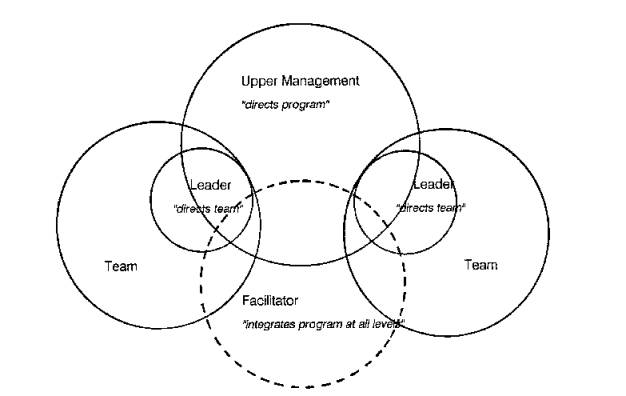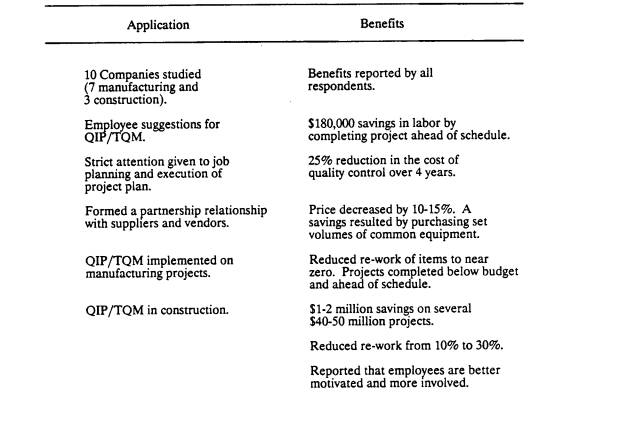(pressing HOME will start a new search)
- ASC Proceedings of the 27th Annual Conference
- Brigham Young University-Provo, Utah
- April 18-20, 1991 pp 87-92
|
(pressing HOME will start a new search)
|
|
QUALITY IMPROVEMENT PROGRAMS FOR CONSTRUCTION
|
Jeff Lew Purdue University West
Lafayette, Indiana |
| This
paper explains and examines an ongoing technique commonly called
"Quality Improvement" (QI) that is currently being used in
industry. A review of the literature available on this subject was made
to obtain a summary of the development of QI to its present state.
Interviews were conducted with several companies to determine the
current state of Q1. An outline of the theory of a "Quality
Improvement Program" is presented next. Following then is an
overview of the principles, practices, and behavior which characterizes
a QIP, and a step-by-step charting of how the program could be applied
to the construction industry. |
INTRODUCTION
TO QUALITY IMPROVEMENT
A method to improve quality in the construction industry is now available in the form of a technique entitled either "Quality Improvement Program" (QIP), "Total Quality Management" (TQM), or a similarly-named program. The program's basic philosophy is based upon a company mission statement complete with objectives, mechanics, and an organization for the Quality Improvement Program. It is a voluntary program that stresses a quality process that is dynamic, and is able to respond to the needs of a world that is changing around us. All of these programs have evolved from an initial concept known as 'quality circles," but in their present forms are more refined and applicable to smaller businesses such as construction companies.
The
construction industry must be tuned to provide products and services that
satisfy the valid requirements and expectations of its customers. Construction
is a competitive business that is hurt by absenteeism, low morale and high
turnover. Quality Improvement is a method that can be used by contractors to
improve their competitive edge.
ORGANIZATION OF QUALITY IMPROVEMENT
A
typical QIP/TQM organization is shown in Fig. 1, and consists of teams, team
leaders, facilitators, and management participation. The actual organization of
a program must be tailored to fit the needs of a particular company. However,
the organization and guidelines of ten different companies were examined and
found to be virtually identical to the program outlined in this paper. The
following paragraphs provide a brief description of the terms describing the
organization of QIP/TQM.

|
| Figure
1
Organization Model of a Quality Improvement Program |
Quality Improvement Tam
The
basic foundation for the entire quality program is the team. The team is a small
group of employees consisting of 3 to 13 people with the usual numbers being 7
to 9. Small groups are used to allow members to informally, comfortably and
effectively communicate their knowledge and ideas with all other members.
The
team members come from the same craft area or task oriented composite crew. This
is a prerequisite so that the members can discuss work related problems that
they have in common. The objects of the discussion are mutual improvement, and
the motivation to encourage self-development. Membership in the team is on a
strictly voluntary basis. Maintaining voluntary participation is important so
that the activities of the program will not interrupt the established work
schedule or procedures of the company, Normally, a team meets for an hour or so
each week at some mutually convenient time.
The
motivation to belong to the group is provided by the personal satisfaction
obtained from recognition given by management for achievements. Members become
selfmotivated when learning that management really cares. Employee recognition
was reported to be a major benefit of Quality Improvement Programs.
In
summary, the groups first sessions are devoted to learning the problem-solving
process, and the Quality Improvement Program, and refining communication skis.
The members are then encouraged and are free to mutually identify problem areas
and proposed solutions. The agreed upon solutions are recommended to management
for implementation.
Team Leaders
The
leaders of a team may be foremen or other supervisors appointed by management or
they can be elected by the group members. There are distinct advantages for
using supervisors as group leaders. First, the risk of creating authority
conflict is avoided. Second, the leadership of the team leader can be used
during the early training of group members. Third, when the team
leader
supports the team activities, the activities of the team will support the
leader. The team leader provides the liaison role between the team members and
the facilitator.
The
training of a team leader must focus upon the knowledge and skills which are
needed to conduct small group discussions and assist members to develop creative
thinking procedures. The five accepted qualifications for an effective group
leader are:
|
Facilitators
Key
to the success of the Quality Improvement Program is the backing of management,
which is the primary task of the facilitator. The facilitator must ensure that
the group efforts are recognized by upper management. For that reason, the
facilitator needs to be a person from middle management such as a project or
contract manager.
Facilitators
must understand the philosophy and dynamics of the program. They must be
experienced and trained in motivation theory, problem solving, group dynamics
and communication skills. A facilitator should be responsible for the start-up
of a new QIP/TQM program, and must direct the activities of several teams to a
common goal. When a common solution is reached by team members, the facilitator
assists the team leaders (or representatives) and supports the presentation of
the solution by the team to upper management. See Fig. 2 for a representation of
the facilitator's role.
 Note:
Double boxes are problem-solving process steps
Single boxes are monitoring process steps |
| Figure
2: Step-by-Step
Process for a Quality Improvement Program |
Management Participation
The
highest level group for the program is provided by management participation,
with the key being the involvement of the Chief Executive Officer. The major
functions of the committee are to set up policies and procedures of the team
activities, and to direct the implementation of a team program. Team management
should determine what areas are off limits to team activities. These areas
usually include wages and salaries company benefits, interpersonal conflicts,
and anything directly concerning union contracts.
Since
commitment and recognition from top management are essential to the success of a
Quality Improvement Program, communication between top management and the team
is critical to team activities. In many cases the committee regularly publicizes
to employees, both members and non-members of the Quality Improvement Program,
the activities, progress, and success of individual teams. The objectives are to
provide the recognition from management, and to encourage more employee
participation.
PROGRAM STEPS
The
Quality Improvement Program process is shown in the flow chart contained in Fig.
2. The first four steps are part of the problem solving process. The last three
steps make up the monitoring phase. The paragraphs that follow explain the steps
in the process.
Improvement Required
The
objective of this step is to identify a subject or the problem area and the
reason for working on it. The key activities include defining & valid
customer requirements, brainstorming, establishing a subject selection matrix,
producing graphs and flow charts. When finished the team will be able to
graphically, or with a flow chart, visualize the need for the improvement.
Selection
of a Problem.
The
team selects the most significant problem from the list in Step 1. A target is
then set for the needed improvement. The key activity is to collect data from
all aspects of the problem, to write a clear problem statement, and to utilize
the data to establish the target.
Problem
Analysis.
This
step identifies and verifies the root causes of the problem area. The team
performs cause and effect analysis on the problem and verifies the selected root
causes with the collected data. Recommended Solution/Implementation. Once the
solution is pinpointed, the team presents the problem and solution directly to
management. The presentation will include graphs and flow charts to show the
solution that will correct the root causes of the problem.
Feedback
and Verification.
This
step is art of a monitoring process the team uses to verify that the root causes
of the problem have been adequately reduced, and the target goal for improvement
has been satisfied. This step uses a key element of comparing the problem
simultaneously before and after implementation, using the same indicator.
Systemizing.
This
step involves seeing that the solution has become part of routine work
activities and that the workers have been properly trained in the correct
techniques. The key element is to ensure that the root cause does not re-occur.
Re-Evaluation.
After
solving a problem the group reviews the process used and examines the lessons
learned in the process. The key activity for this step is to evaluate the team
effectiveness and then plan future activities for solving remaining problems.
DISCUSSION OF PROGRAM RESULTS
The
users of QIP/TQM reported benefits that are summarized in Table 1. While all
respondents reported benefits from the program, not all of the benefits could be
quantified in monetary terms, and showed minimal results at best. For this
reason, and after a number of years, the program was dropped by two companies.
Their reasons are summarized as follows:
|
QI TACTICS FOR CONSTRUCTION FIRMS
Historic
experience indicates that quality improvements can usually be made in most
operations. But the question that arises is: are these improvements short-lived,
or can they become permanent? This is a real concern for construction
operations. The following are some tactics for QIP/TQM that would help
construction firms, and which vary somewhat from the typical program outlined in
this paper.
|
CONCLUSION AND RECOMMENDATIONS
The
five points listed under Team Leaders (page four) are the basic qualities of a
good supervisor and manager. Those people within a company who exhibit these
qualities are usually promoted quickly, and tend to continue to be successful.
They then practice their own form of QIP/TQM that is informal and customized to
their own management style. The point here is that once people learn to
communicate, listen, and manage well, a company may not need a special program
to make improvements. These improvements would happen naturally. However, to be
properly managed from a QIP/TQM aspect, a company may need to employ a program
to ensure that its people are trained to the best of their abilities. Training
is essential to start a successful program and have it grow.
| Table
1. Summary
of QIP/TQM applications and benefits. |
 |
Good
management techniques require looking at people, in addition to applying sound
management principles to a construction project. QIP/TQM could provide the
construction industry a methodology to involve workers, supervisors and
management in a team approach to solving problems. QIP/TQM allows employees to
become part of the solution, rather than part of the problem. This program is an
interesting and dynamic method to improve productivity, quality, and management
of construction work.
QIP/TQM
can be adapted for use in the construction industry. Construction firms thinking
of such a program should consider the following recommendations:
|
REFERENCES
|